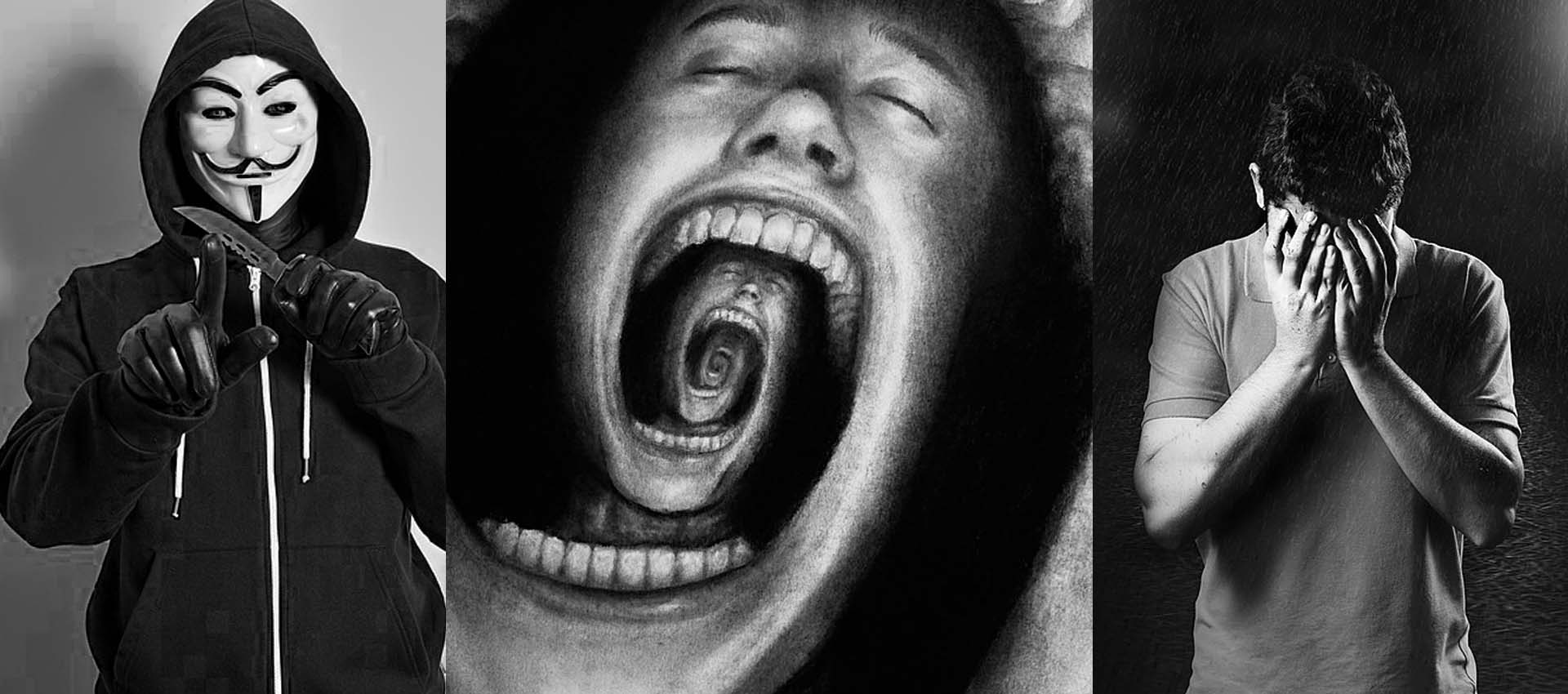The Mad, the Bad and The Sad: They All Deserve Some Compassion
Table of Contents
If one spends any time around prisons, it does not take long before you hear inmates classified as either mad, bad or sad. It is a simplistic characterisation, and it carries pejorative undertones, but there is some sense in its development. Of these three ‘types’, two of them, the ‘mad’ and the ‘sad’ are worthy of considerable compassion rather that derision. The third type, the ‘bad’ are often marked by an innate desire to harm without remorse and most people find these inmates more difficult to view with any compassion, though they too are worthy of compassion.
This article discusses these three groups and while the language will change, the grouping will remain. We will then consider the role of a compassionate approach to prison life and how it is worth the effort to develop a more compassionate approach in place of the punitive approach so often adopted.
Psychopathy – ‘The Bad’
Different terms have been used to discuss psychopathy over the years, and while there are some differences between the various descriptions, the core elements are similar. The most common terms include psychopath, sociopath, antisocial personality disorder, dark triad, and Machiavellian syndrome. For our purposes it will be easier to simply accept that they are near enough to the same and I will refer to them collectively as psychopaths. Even though this is not the most contemporary term for this group, it is well known, and most people will have some sense of what it means.
To understand what psychopathy is, it is important to put it into the context of personality and personality disorders. Notions of personality have changed over decades of research and even now, current ideas of how personality disorder in general, and psychopathy in particular, are far from complete[1]. The American Psychiatric Association says personality is:
“… the way of thinking, feeling and behaving that makes a person different from other people. An individual’s personality is influenced by experiences, environment (surroundings, life situations) and inherited characteristics. A person’s personality typically stays the same over time.”[2]
While a personality disorder is described as:
“…a way of thinking, feeling and behaving that deviates from the expectations of the culture, causes distress or problems functioning, and lasts over time.”[3]
Psychopathy is analogous to antisocial personality disorder in DSM-V and is just one of the described personality disorders. The diagnostic criteria point to a range of characteristic features although most of these features flow from the core problems which are:
“a callous lack of empathy, conning and manipulative behaviour, and lack of remorse or guilt.”[4]
The cause of psychopathy has been debated for many years, and the understanding has developed with the growing knowledge of personality development, neuroscience, and genetics. The contemporary view is that psychopathy is strongly influenced by genetics and its expression is tightly bound to neuroscience but in some cases, growing up in an adversarial, traumatic environment along with the genetic background creates a toxic mix for the full expression of psychopathy[5].
Acknowledging the neurobiology of psychopathy has implications for understanding the locus of control for the sufferer’s behaviour and for treatment possibilities. Treatment of psychopathy is typically regarded as difficult or impossible and, in a subset, may make matters worse[6].
The rate of psychopathy in the general population is only about 1% but comprise 15-25% of inmates in North American prisons[7]. Similar rates are reported in Australian prisons[8]. Given the core elements of psychopathy, the concentration of psychopathic individuals in a prison environment is not surprising. Unsurprisingly, when psychopaths do find their way to prison because of criminal behaviour, the lack of rehabilitation prospects also means recidivism rates are very high, as much as 85%[9].
It is worth noting that similar rates of psychopathy are also present in subsets of the community. For example, CEO’s, politicians, lawyers, surgeons, and the clergy are credited with similar rates of psychopathy. Indeed, the fact that psychopathy rates are higher among the more powerful leads to an argument that the presence of psychopathy among the human gene pool has served a longstanding purpose[10].
Personal Impairment – ‘The Mad’
Mental Illness That Causes Crime
The way ‘mental illness’ is defined depends on the context it is being considered. For many, ideas of mental illness are extremely broad and account for almost any psychological condition that affects the way a person feels and behaves. However, legal definitions are narrower.
The Mental Health Act[11] is used to control the involuntary treatment of people who are mentally ill or mentally disordered and defines mental illness as:
“… a condition that seriously impairs, either temporarily or permanently, the mental functioning of a person and is characterised by the presence in the person of any one or more of the following symptoms—
- delusions,
- hallucinations,
- serious disorder of thought form,
- a severe disturbance of mood,
- sustained or repeated irrational behaviour indicating the presence of any one or more of the symptoms referred to in paragraphs (a)–(d).”
Mental Illness and Disability in Prison
Mentally ill people can commit crimes, and in some circumstances, the presence of mental illness can lead to the person being found not guilty by reason of mental illness. This is a long-established common-law principle derived from the M’Naghten case[12] that now requires that a defendant who wants to invoke an insanity defence must show that:
- They laboured under the defect of reason,
- The behaviour or crime was caused by a disease of the mind; so that either
- The person did not know the nature and quality of the acts, or
- did not know that was being done was wrong.
Practically, this means that if a person commits a crime while mentally ill, that crime needs to be the product of the delusions or hallucinations. For example, if someone has delusions that their spouse has been possessed by an evil force, and then kills them to rid them of the evil force, then it is possible they will be found not guilty by reason of mental illness. While these individuals avoid a criminal conviction and prison, they are instead managed by a forensic psychiatric hospital with review by the Mental Health Review Tribunal. However, this is a rare defence, involving less that 2% of cases in NSW courts[13].
In contrast, and considering mental health more broadly, the numbers of prisoners who have problems with mental health conditions is remarkably high[14]. 65% of women and 36% of men in prison report an earlier history of being diagnosed or treated for a mental health condition while 20% have reported earlier episodes of self-harm[15]. While these individuals committed offences that did not meet the conditions required for a mental health defence described above, there will be little doubt that their mental health problems contributed to their crime. The court may have taken this into account and delivered some leniency in sentencing. However, the sad truth is that a substantial part of the prison population labours under the effect of serious mental health issues. These issues include illnesses like schizophrenia, bipolar disorder, personality dysfunction, anxiety, PTSD, depression, and substance abuse. More often than not, they are affected by more than one of these groups.
Intellectual Disability in Prison
Intellectual disability is not a form of ‘madness’ but for many lay people, especially in a historical sense in some subcultures, it would have been grouped with psychiatric illness. Intellectual disability is overrepresented in prisons. The rate of intellectual disability in the general population is just 0.99%[16] whereas in Australian prisons, intellectual disabilities comprise about 13% of population[17].
In the early 1900’s some believed that people with intellectual disability were predisposed to criminality[18], but this view has lost support. Instead, research suggests that a tendency to crime is related to the effect of psychological trauma and sociological impoverishment[19].
Another crucial factor is that suspects and defendants with an intellectual disability may not be able to protect their own rights as well as some others. A range of reasons might include not wanting their disability to be recognised and try to cover it up, pretending to understand rights but failing to do so, not properly understanding commands or instructions during complex processes, feeling overwhelmed within the presence of police, lawyers and courts, becoming emotionally distraught, saying what they think officers wants to hear, being confused about who is responsible for the crime and confessing even though they are innocent, and so on[20].
Circumstance – ‘The Sad’
Once you account for the bad and the mad, the sad make up the rest. This group is comprised with people who are not affected by a ‘dark personality style’ or of some form of mental or intellectual disability. These will be people who have essentially been going about their daily lives, and either woke up one day to the worst day of their lives when some tragedy occurred, or they embarked on something that ‘seemed like a good idea at the time’ but turned out to be a slippery slope that directed them to a situation that became criminal. These people are often people just like you, your neighbour, or your friend. There is no evidence that they had prior interest in criminal behaviour though you might find that they had looser boundaries, or more ‘easy going ideas’ about rules. In any case, they are people whose backgrounds are not much different to our own, or people we know in everyday life.
Compassion for Criminals
Compassion was described by Kanov et al. as:
“a relational process that involves noticing another person’s pain, experiencing an emotional reaction to his or her pain, and acting in some way to help ease or alleviate the pain.”[21]
It is an important human characteristic, and one that most societies aspire to elevating as a prominent part of its existence. Compassion has brought about changes of societal norms in recent centuries including the abolition of slavery, humanising mental health and disability care and providing foreign aid to the people of countries in crisis. Still, we have a long way to go and there are many places where additional compassion could make a difference in the lives of others. Prisons and prisoners are one such area that additional compassion could make a difference to the lives of others.
One reason prisoners are not recipients of societal compassion is because of the perception that they are wrongdoers – people who have sought to harm others and not worthy of compassion. However, the compassionate view is in the best interest of society. American prisons are typically difficult environments with overcrowding and the treatment of prisoners is focused on punishment[22]. At the other extreme, Bastoy Island in Norway is a prison that emphasises the value of providing compassionate care of inmates and their families instead of delivering a punitive experience[23]. Interestingly, and perhaps contrary to popular expectation, prison systems that focus on punishment have much higher rates of reoffending. In Australia, 73% of prisoners have been in prison on more than one occasion[24] but in contrast, the reoffending rate of prisoners leaving Bastoy Island is only 18%[25].
Compassion can be easier if the person is thought to have no control over what happened to them, and the situation can be reframed as some form of unfortunate situation. Most of the time, people do not apply this to prisoners but if you consider the ‘mad, bad and sad’ categorisation, perhaps they are deserving of a more compassionate approach.
- People with ‘madness’ don’t choose to have mental or intellectual problems and if their involvement in crime and being in prison is a consequence of their health problems, perhaps they deserve compassion simply because they had little control over their situation.
- People with ‘badness’ are a product of dominant genetic influences. While they have characteristics that are unlikeable and difficult for others to relate to, particularly those who are openly manipulative and malicious, they did not choose for this to be their life. It is largely a genetic influence and not something they can easily control or get treatment for.
- People with ‘sadness’ are in many respects like the rest of us, and typically have had a really bad day and something tragic has happened. It could have happened to almost anyone under the right circumstances.
Closing Remarks
Compassion is often in short supply, but especially for prisoners. Criminals are often perceived as deserving of punishment, perhaps informed more by a sense and desire for retribution or vengeance. However, prisoners are typically an unfortunate group of individuals. Not just because they are in prison, but because they are affected by negative influences in their life including serious mental illness, social deprivation, trauma, genetically mediated personality dysfunction, bad luck and a series of bad choices creating a slippery slope toward disaster. There is real world evidence that when a prison exhibits a compassionate approach the outcomes are superior. Not just to make the lives of prisoners better, but for the benefit of society with lower rates of reoffending and the return of functional people back to society when sentences are complete.
References
[1] Peter Tyrer, ‘New Approaches to the Diagnosis of Psychopathy and Personality Disorder’ (Pt The Royal Society of Medicine) (2004) 97(8) Journal of the Royal Society of Medicine 371-374.
[2] Rachel Robitz, ‘What Are Personality Disorders?’, Personality Disorders (Blog Post or Webpage, November 2018) <https://www.psychiatry.org/patients-families/personality-disorders/what-are-personality-disorders>.
[3] American Psychiatric Association, Diagnostic and Statistical Manual of Mental Disorders (American Psychiatric Association, 5th ed, 2013); American Psychiatric Association, Dsm-V Personality Disorders (online at 9 Oct 2020). American Psychiatric Association, Diagnostic and Statistical Manual of Mental Disorders (n
[4] B. Verschuere and L. Te Kaat, ‘What Are the Core Features of Psychopathy? A Prototypicality Analysis Using the Psychopathy Checklist-Revised (Pcl-R)’ (2020) 34(3) (2019/01/17) J Pers Disord 410-419.
[5] Nathaniel E. Anderson and Kent A. Kiehl, ‘Psychopathy: Developmental Perspectives and Their Implications for Treatment’ (2014) 32(1) Restorative neurology and neuroscience 103-117.
[6] Dennis E. Reidy, Megan C. Kearns and Sarah DeGue, ‘Reducing Psychopathic Violence: A Review of the Treatment Literature’ (2013) 18(5) Aggression and violent behavior 527-538.
[7] Kent A. Kiehl and Morris B. Hoffman, ‘The Criminal Psychopathy: History, Neuroscience, Treatment and Economics’ (2011) 51 Jurimetrics 355-397.
[8] Stephane Shepherd, Rachel Campbell and James Ogloff, ‘Psychopathy, Antisocial Personality Disorder, and Reconviction in an Australian Sample of Forensic Patients’ (2016) 62 International Journal of Offender Therapy and Comparative Criminology.
[9] Ralph C. Serin, ‘Violent Recidivism in Criminal Psychopaths’ (1996) 20(2) Law and Human Behavior 207-217.
[10] Janko Međedović et al, ‘Interpersonal and Affective Psychopathy Traits Can Enhance Human Fitness’ (2017) 3(4) Evolutionary Psychological Science 306-315.
[11] Mental Health Act 2007 (NSW).
[12] R V M’naghten (1843) 8 ER 718.
[13] Lily Mayers, ‘Nsw Government Introduces Bill to Change Verdict in Court Cases Where Defendant Is Found to Be Mentally Ill.’, (Blog Post or Webpage, 3 June 2020) <https://www.abc.net.au/news/2020-06-03/nsw-government-bill-to-introduce-new-verdict-act-proven/12316732>.
[14] ‘The Health of Australian Prisoners 2018’, (Report No PHE 246, Australian Institute of Health and Welfare, 30 May 2019) <https://www.aihw.gov.au/reports-data/population-groups/prisoners/overview>.
[15] Ibid.
[16] Australian Institute of Health Welfare, ‘The Definition and Prevalence of Intellectual Disability in Australia’ (Canberra No DIS 2, AIHW, <https://www.aihw.gov.au/reports/disability/definition-prevalence-intellectual-disability-au>.
[17] ‘People Who Have an Intellectual Disability and the Criminal Justice System’, (Report, Villamanta Disability Rights Legal Service Inc., April 2012) <https://www.villamanta.org.au/documents/People%20with%20ID%20in%20Criminal%20Justice%20System.pdf>.
[18] Leigh A Davis, ‘People with Intellectual Disabilities in the Criminal Justice Systems: Victims & Suspects’ (Information Booklet, The Arc, <https://thearc.org/wp-content/uploads/forchapters/Criminal%20Justice%20System.pdf>.
[19] Ibid.
[20] Ibid.
[21] J.M. Kanov et al, ‘Compassion in Organizational Life.’ (Pt 47) (2004) 6 American Behavior Scientist 808.
[22] Etienne Benson, ‘Rehabilitate or Punish?’ (2003) 34(7) Monitor on Pschology.
[23] Erwin James, ‘The Norwegian Prison Where Inmates Are Treated Like People’, The Guardian (online, Mon 25 Feb 2013) <https://www.theguardian.com/society/2013/feb/25/norwegian-prison-inmates-treated-like-people>.
[24] , ‘The Health of Australian Prisoners 2018’ (n
[25] John Kuroski, ‘Why the World’s Cushiest Prison Is Also among Its Most Effective’, (Blog Post or Webpage, January 7, 2019) <https://allthatsinteresting.com/bastoy-prison>.






